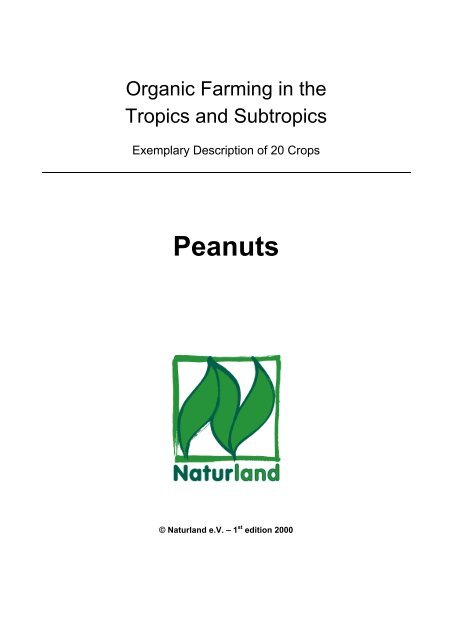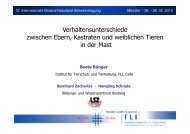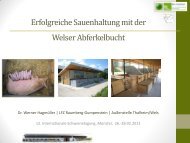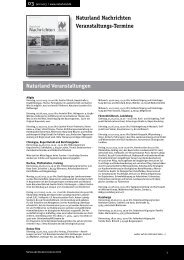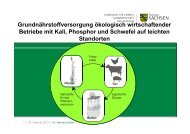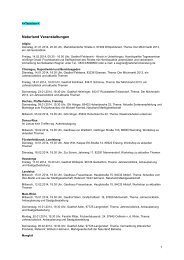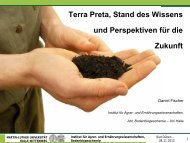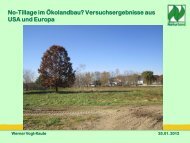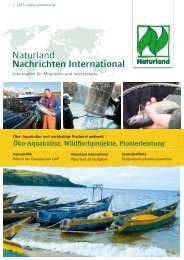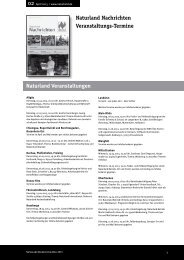Organic Farming in the Tropics and Subtropics: Peanuts - Naturland
Organic Farming in the Tropics and Subtropics: Peanuts - Naturland
Organic Farming in the Tropics and Subtropics: Peanuts - Naturland
Create successful ePaper yourself
Turn your PDF publications into a flip-book with our unique Google optimized e-Paper software.
<strong>Organic</strong> <strong>Farm<strong>in</strong>g</strong> <strong>in</strong> <strong>the</strong><br />
<strong>Tropics</strong> <strong>and</strong> <strong>Subtropics</strong><br />
Exemplary Description of 20 Crops<br />
<strong>Peanuts</strong><br />
© Naturl<strong>and</strong> e.V. – 1 st edition 2000
These cultivation guidel<strong>in</strong>es have been published by Naturl<strong>and</strong> e.V. with <strong>the</strong> k<strong>in</strong>d support of <strong>the</strong><br />
Deutsche Gesellschaft für Technische Zusammenarbeit mbH (GTZ, German Agency for Technical<br />
Cooperation) f<strong>in</strong>anced by <strong>the</strong> Bundesm<strong>in</strong>isterium für Wirtschaftliche Zusammenarbeit (BMZ,<br />
Federal M<strong>in</strong>istry for Development Cooperation). The cultivation recommendations at h<strong>and</strong> for 20<br />
crops of <strong>the</strong> tropics <strong>and</strong> subtropics be<strong>in</strong>g of significant importance for <strong>the</strong> world economy were<br />
written by various authors.<br />
Naturl<strong>and</strong> would like mention <strong>the</strong> follow<strong>in</strong>g authors <strong>and</strong> thank <strong>the</strong>m for <strong>the</strong>ir contributions:<br />
Franz Augstburger, Jörn Berger, Udo Censkowsky,<br />
Petra Heid, Joachim Milz, Christ<strong>in</strong>e Streit.<br />
The cultivation guidel<strong>in</strong>es are available <strong>in</strong> English, Spanish <strong>and</strong> German for <strong>the</strong> follow<strong>in</strong>g crops:<br />
banana, brazil nut, cashew nut, cocoa, coconut, coffee,<br />
cotton, hibiscus, macadamia, mango, papaya, peanut,<br />
pepper, p<strong>in</strong>eapple, sugar cane, sesame, tea, vanilla.<br />
The cultivation guidel<strong>in</strong>es for Bananas, Mangoes, P<strong>in</strong>eapples <strong>and</strong> Pepper were revised <strong>in</strong> 2001 for<br />
<strong>the</strong> United Nations Conference on Trade <strong>and</strong> Development (UNCTAD) by Udo Censkowsky <strong>and</strong><br />
Friederike Höngen.<br />
In 2002 two more guidel<strong>in</strong>es, for rice <strong>and</strong> date palms, were published <strong>in</strong> English.<br />
All <strong>the</strong> authors emphasize, that <strong>the</strong> cultivation recommendations at h<strong>and</strong> can just provide general<br />
<strong>in</strong>formation. They do not substitute technical assistance to <strong>the</strong> farmers with regard to <strong>the</strong> location.<br />
All <strong>in</strong>dications, data <strong>and</strong> results of this cultivation guidel<strong>in</strong>es have been compiled <strong>and</strong> crosschecked<br />
most carefully by <strong>the</strong> authors. Yet mistakes with regard to <strong>the</strong> contents cannot be<br />
precluded. The <strong>in</strong>dicated legal regulations are based on <strong>the</strong> state of <strong>the</strong> year 1999 <strong>and</strong> are subject<br />
to alterations <strong>in</strong> future. Consequently all <strong>in</strong>formation has to be given <strong>in</strong> exclusion of any obligation<br />
or guarantee by Naturl<strong>and</strong> e.V. or <strong>the</strong> authors. Both Naturl<strong>and</strong> e.V. <strong>and</strong> authors <strong>the</strong>refore do not<br />
accept any responsibility or liability.<br />
Fur<strong>the</strong>rmore <strong>the</strong> authors k<strong>in</strong>dly call upon for critical remarks, additions <strong>and</strong> o<strong>the</strong>r important<br />
<strong>in</strong>formation to be forwarded to <strong>the</strong> address below. The cultivation guidel<strong>in</strong>es will be updated<br />
regularly by Naturl<strong>and</strong> e.V.<br />
Naturl<strong>and</strong> e.V.<br />
Kle<strong>in</strong>haderner Weg 1<br />
82166 Gräfelf<strong>in</strong>g<br />
Germany<br />
phone: +49 - (0)89 - 898082-0<br />
fax: +49 - (0)89 - 898082-90<br />
e-mail: naturl<strong>and</strong>@naturl<strong>and</strong>.de<br />
website: www.naturl<strong>and</strong>.de<br />
We pass our gratitude to Peter Brul of Agro Eco for his helpful comments on <strong>the</strong> manuscript. Our<br />
best thanks are also devoted to all supporters of this publication, <strong>in</strong> particular Mrs Sybille<br />
Groschupf who cleaned up <strong>the</strong> text from errors <strong>in</strong> strenuous detail work <strong>and</strong> did <strong>the</strong> attractive<br />
layout..
II Special section: <strong>Organic</strong> Peanut Cultivation<br />
Naturl<strong>and</strong> e.V. – 1 st edition 2000<br />
Index<br />
1. Introduction .......................................................................................................... 1<br />
1.1. Botany................................................................................................................ 1<br />
1.2. Varieties <strong>and</strong> countries of orig<strong>in</strong> ..................................................................... 1<br />
1.3. Uses <strong>and</strong> contents ............................................................................................ 2<br />
2. Aspects of plant cultivation ................................................................................ 3<br />
2.1. Site requirements.............................................................................................. 3<br />
2.1.1. Climatic requirements ...................................................................................... 3<br />
2.1.2. Soil requirements ............................................................................................. 4<br />
2.2. Seeds ................................................................................................................. 4<br />
2.2.1. On farm seed production <strong>and</strong> seed preparation............................................... 4<br />
2.3. Sow<strong>in</strong>g methods ............................................................................................... 5<br />
2.3.1. Prepar<strong>in</strong>g seed beds........................................................................................ 5<br />
2.3.2. Sow<strong>in</strong>g ............................................................................................................. 5<br />
2.4. Cultivation systems <strong>and</strong> diversification possibilities.................................... 6<br />
2.4.1. Crop rotation .................................................................................................... 6<br />
2.4.2. Mixed crops...................................................................................................... 7<br />
2.5. Supply<strong>in</strong>g nutrients <strong>and</strong> organic fertilisation management ......................... 8<br />
2.5.1. Nutrient requirements....................................................................................... 8<br />
2.5.2. Fertiliser ........................................................................................................... 8<br />
2.6. Biological methods of plant protection .......................................................... 9<br />
2.6.1. Diseases .......................................................................................................... 9<br />
2.6.2. Pests ................................................................................................................ 9<br />
2.7. Crop cultivation <strong>and</strong> protection..................................................................... 10<br />
2.7.1. Weed management........................................................................................ 10<br />
2.7.2. Irrigation ......................................................................................................... 11<br />
2.8. Harvest<strong>in</strong>g <strong>and</strong> post harvest treatment ........................................................ 11<br />
2.8.1. Time of harvest<strong>in</strong>g.......................................................................................... 11<br />
2.8.2. Harvest<strong>in</strong>g methods ....................................................................................... 12<br />
2.8.3. Post harvest treatment................................................................................... 13<br />
3. Product specifications....................................................................................... 14<br />
3.1. The aflatox<strong>in</strong> problem..................................................................................... 15<br />
3.1.1. Aflatox<strong>in</strong> test<strong>in</strong>g.............................................................................................. 17<br />
3.2. Peanut seeds................................................................................................... 17<br />
3.2.1. Process<strong>in</strong>g ..................................................................................................... 17<br />
3.2.2. Quality requirements...................................................................................... 18<br />
3.2.3. Packag<strong>in</strong>g <strong>and</strong> storage .................................................................................. 19
II Special section: <strong>Organic</strong> Peanut Cultivation<br />
1. Introduction<br />
<strong>Organic</strong> peanut cultivation<br />
Domestic cultivation of peanuts began at least 4000 years ago <strong>in</strong> present-day northwestern<br />
Argent<strong>in</strong>a <strong>and</strong> <strong>in</strong> sou<strong>the</strong>rn Bolivia. The plant probably reached Ch<strong>in</strong>a before<br />
<strong>the</strong> colonisation era; it also arrived <strong>in</strong> Africa dur<strong>in</strong>g <strong>the</strong> 16 th century <strong>and</strong><br />
subsequently created a second centre of development by spread<strong>in</strong>g through out <strong>the</strong><br />
whole of Asia. Today, peanuts are cultivated <strong>in</strong> every tropical <strong>and</strong> subtropical<br />
country.<br />
1.1. Botany<br />
<strong>Peanuts</strong> (Arachis hypogaea L.) belong to <strong>the</strong> legum<strong>in</strong>osae family <strong>and</strong> to <strong>the</strong><br />
subfamily of papilionoideae. It is a herbaceous, annual type of plant that grows to a<br />
height of 20-60 cm. Depend<strong>in</strong>g on <strong>the</strong> species, <strong>the</strong> plants may grow upright <strong>and</strong><br />
sideways with <strong>the</strong>ir sidewards shoots to a breadth of 30-80 cm. The ma<strong>in</strong> stem<br />
usually rema<strong>in</strong>s upright. The taproots penetrate to a depth of 90-120 cm, creat<strong>in</strong>g<br />
branches with<strong>in</strong> <strong>the</strong> upper soil levels that are <strong>the</strong>n populated by rhizobia <strong>and</strong><br />
mycorhiza. Arachis hypogaea does not grow <strong>in</strong> <strong>the</strong> wild, <strong>the</strong> wild species are<br />
perennial. The blossoms open up <strong>in</strong> <strong>the</strong> morn<strong>in</strong>g time, usually after self-poll<strong>in</strong>ation<br />
has taken place. The blossom<strong>in</strong>g period usually beg<strong>in</strong>s 3-4 weeks after sow<strong>in</strong>g, <strong>and</strong><br />
can last for up to 2 months. All of <strong>the</strong> species are geocarpy reproducers, i.e. <strong>the</strong>y<br />
s<strong>in</strong>k a stalk-like structure called a peg <strong>in</strong>to <strong>the</strong> ground after fertilisation, <strong>in</strong> order to<br />
grow <strong>the</strong> peanut seeds <strong>the</strong>re.<br />
1.2. Varieties <strong>and</strong> countries of orig<strong>in</strong><br />
The many different types of peanuts are sorted <strong>in</strong>to two different subgroups which<br />
can be <strong>in</strong>tercrossed amongst each-o<strong>the</strong>r:<br />
Arachis hypogaea<br />
ssp. hypogaea (Virg<strong>in</strong>ia variety)<br />
Long vegetation period, dark green plant, spread<strong>in</strong>g, bunch form, many branches,<br />
mostly two seeds/pod, dist<strong>in</strong>ct dormancy period of 30-180 days, meagre resistance<br />
aga<strong>in</strong>st Cercospora, anthracnose.<br />
ssp. fastigiata (Spanish Valencia variety)<br />
Short vegetation period, light green leaves, upright growth, pods with 2-6 seeds are<br />
concentrated around <strong>the</strong> ma<strong>in</strong> stem. Spanish varieties usually have two seeds/pod,<br />
Valencia varieties have pods with 3-6 seeds, thick stalks <strong>and</strong> far less secondary or<br />
tertiary branches than o<strong>the</strong>r Spanish varieties. No dormancy, no resistance to<br />
Cercospora, anthracnose.<br />
Naturl<strong>and</strong> e.V. – 1 st edition 2000 page 1
II Special section: <strong>Organic</strong> Peanut Cultivation<br />
<strong>Peanuts</strong> are cultivated throughout all tropical <strong>and</strong> subtropical countries, as well as <strong>in</strong><br />
those temperate countries which enjoy long , hot summers.<br />
The export of peanuts grown <strong>in</strong> organic farms has been discont<strong>in</strong>ued <strong>in</strong> many<br />
countries ow<strong>in</strong>g to problems with aflatox<strong>in</strong>. The fur<strong>the</strong>r development of exemplary,<br />
organic cultivation systems has stagnated <strong>in</strong> many countries <strong>and</strong> cultivation for<br />
export, e.g. to Germany, is currently limited to USA, Ch<strong>in</strong>a, Egypt <strong>and</strong> Israel. The<br />
aflatox<strong>in</strong> problem can be solved though. It is <strong>the</strong>refore dealt with thoroughly with<strong>in</strong><br />
this cultivation guide (comp. 3.1.).<br />
In <strong>the</strong> USA, <strong>the</strong> yields from organic peanut cultivation are around 2.2 - 3.2 t/ha, <strong>in</strong><br />
Ch<strong>in</strong>a 2.5 – 3.5 t/ha <strong>and</strong> <strong>in</strong> Zimbabwe around 2.8 t/ha of seeds <strong>in</strong> pods. The world<br />
average yield is around 1.1 t/ha <strong>and</strong> <strong>the</strong> potential yield around 9 t/ha.<br />
1.3. Uses <strong>and</strong> contents<br />
<strong>Peanuts</strong> are one of <strong>the</strong> most important food crops <strong>in</strong> <strong>the</strong> <strong>Tropics</strong> <strong>and</strong> <strong>Subtropics</strong>.<br />
The lion’s share of <strong>the</strong> production is consumed locally <strong>in</strong> <strong>the</strong> producer countries. In<br />
many countries, farm systems which provide for daily needs generally have a very<br />
low yield. Any changes made to <strong>the</strong> cultivation systems <strong>in</strong> order to extract higher<br />
yields e.g. cultivation for <strong>the</strong> purpose of sell<strong>in</strong>g, have – if at all possible – social<br />
consequences, which must also be taken <strong>in</strong>to consideration 1 .<br />
The peanut has a very useful prote<strong>in</strong> <strong>and</strong> fat composition <strong>and</strong> <strong>the</strong>refore represents a<br />
valuable source of food for humans. The seeds are eaten raw, cooked or roasted,<br />
<strong>and</strong> also processed <strong>in</strong>to peanut butter, sweets <strong>and</strong> snacks, or used to make soups<br />
<strong>and</strong> sauces. 40% of <strong>the</strong> world yield is used to make oil. A cake conta<strong>in</strong>s 40-50%<br />
easily digestible prote<strong>in</strong>; peanut flour is won from it, <strong>and</strong> used to enrich foodstuffs<br />
with prote<strong>in</strong>, for example manioc flour. Foliage <strong>and</strong> pressed cakes are used as<br />
prote<strong>in</strong>-rich fodder. The pods are used for fuel, as raw fibres <strong>in</strong> fodder, as raw<br />
material for light construction boards, to obta<strong>in</strong> cellulose <strong>and</strong> for compost<strong>in</strong>g.<br />
Peanut seeds’ contents 2 :<br />
Contents %<br />
water 5,0<br />
prote<strong>in</strong> 30,0<br />
fat 48,0<br />
carbohydrates 15,5<br />
Raw fibres 3,0<br />
Ash 2,0<br />
1 RUNDGREN, G. (1998): Persönliche Mitteilung. Internationale Zertifizierung <strong>and</strong> Beratung.<br />
Naturl<strong>and</strong> e.V. – 1 st edition 2000 page 2
II Special section: <strong>Organic</strong> Peanut Cultivation<br />
2. Aspects of plant cultivation<br />
2.1. Site requirements<br />
The peanut is very adaptable, <strong>and</strong> is cultivated <strong>in</strong> cont<strong>in</strong>ental areas with hot<br />
summers from <strong>the</strong> 45° nor<strong>the</strong>rn to <strong>the</strong> 40° sou<strong>the</strong>rn latitude.<br />
2.1.1. Climatic requirements<br />
Temperature<br />
The rate of growth <strong>and</strong> vegetation period of <strong>the</strong> peanut are highly <strong>in</strong>fluenced by<br />
temperature. 30-34°C is optimum for germ<strong>in</strong>ation (max. 45°C, m<strong>in</strong>. 15°C). Under<br />
20°C, <strong>the</strong> capacity to germ<strong>in</strong>ate, <strong>the</strong> rate of growth <strong>and</strong> development are rapidly<br />
reduced, <strong>and</strong> at around 14°C <strong>the</strong>y cease altoge<strong>the</strong>r. 25-30°C is optimum for<br />
vegetative growth. Temperatures above 34°C can damage <strong>the</strong> flower formation. The<br />
optimum temperature <strong>in</strong>fluences <strong>the</strong> net rate of photosyn<strong>the</strong>sis, <strong>the</strong> flower formation<br />
<strong>and</strong> <strong>the</strong> growth of <strong>the</strong> pods, <strong>and</strong> is <strong>the</strong>refore responsible for <strong>the</strong> greater yields<br />
outside <strong>the</strong> hot tropics 3 . Night-time temperatures should not s<strong>in</strong>k below 10°C dur<strong>in</strong>g<br />
<strong>the</strong> fructification process. Frost will always kill off <strong>the</strong> plant.<br />
Light<br />
The peanut can tolerate shade, it poses no problems when cultivated with trees or<br />
with o<strong>the</strong>r, mixed crops. When placed <strong>in</strong> shade, <strong>the</strong> leaves get bigger, <strong>and</strong> <strong>the</strong><br />
number of reproductive organs lessens (<strong>the</strong>re are too many of <strong>the</strong>se anyway),<br />
mean<strong>in</strong>g that <strong>the</strong> yield will only be reduced if <strong>the</strong> plant is subjected to extremely<br />
shady conditions. When <strong>the</strong> light is very <strong>in</strong>tense, <strong>the</strong> peanut (a C3-plant) achieves a<br />
comparable level of photosyn<strong>the</strong>sis as C4-plants. Arachis hypogaea is <strong>in</strong> a<br />
photoperiodic sense, practically neutral, although photoperiodic sensitive <strong>and</strong><br />
<strong>in</strong>sensitive varieties also exist.<br />
Water<br />
The optimum time to sow, which corresponds <strong>in</strong> many places with <strong>the</strong> ra<strong>in</strong>y season,<br />
depends largely on <strong>the</strong> ra<strong>in</strong>, as <strong>the</strong> yield s<strong>in</strong>ks rapidly when <strong>the</strong> plants are sown<br />
outside <strong>the</strong> optimum plant<strong>in</strong>g time. The germ<strong>in</strong>ation process requires enough air <strong>in</strong><br />
<strong>the</strong> soil. A grown peanut plant can tolerate flood<strong>in</strong>g conditions for up to a week,<br />
provid<strong>in</strong>g <strong>the</strong> water <strong>the</strong>n flows away completely without leav<strong>in</strong>g beh<strong>in</strong>d any stagnant<br />
pools 4 . In case of regular heavy rea<strong>in</strong> fall dur<strong>in</strong>g <strong>the</strong> vegetation period, <strong>the</strong> ground<br />
must be well dra<strong>in</strong>ed, or <strong>the</strong> peanuts planted on ridges.<br />
Peanut is more resistant to drought than cotton, yet less so than sorgo. Nitrogen<br />
fix<strong>in</strong>g can be <strong>in</strong>fluenced by drought.<br />
2 SAVAGE, G. P. <strong>and</strong> KEENAN, J. I. (1994): The composition <strong>and</strong> nutritive value of groundnut kernels. In:<br />
SMARTT, J.: The groundnut crop. Chapman & Hall, London.<br />
3 FRANKE, G. (1994): Nutzpflanzen der Tropen <strong>and</strong> Subtropen, Bd.3, Ulmer, Stuttgart.<br />
4 WEISS, E. A. (1983): Tropical oilseed crops. Longman, London.<br />
Naturl<strong>and</strong> e.V. – 1 st edition 2000 page 3
II Special section: <strong>Organic</strong> Peanut Cultivation<br />
500-1000 mm of ra<strong>in</strong>fall dur<strong>in</strong>g <strong>the</strong> growth period will produce good yields among<br />
<strong>the</strong> late ripen<strong>in</strong>g varieties (up to 145 days vegetation period). 300-500 mm permits<br />
<strong>the</strong> plant<strong>in</strong>g of early ripen<strong>in</strong>g varieties (up to 100 days vegetation period). 250-400<br />
mm of ra<strong>in</strong>fall, when evenly spread, is sufficient for varieties that ripen extremely<br />
early. The type of soil, <strong>and</strong> its capacity to reta<strong>in</strong> water after it has been saturated<br />
with water before sow<strong>in</strong>g also play an important role. At least 300 mm of ra<strong>in</strong>fall<br />
should be available between <strong>the</strong> plant’s appearance <strong>and</strong> <strong>the</strong> ma<strong>in</strong> flower<strong>in</strong>g period,<br />
<strong>in</strong> order to ensure sufficient vegetative growth, because <strong>the</strong>re is a direct<br />
correspondence between <strong>the</strong> number of branches <strong>and</strong> flowers, <strong>and</strong> <strong>the</strong> eventual<br />
number of pods. Moist soil allows <strong>the</strong> pegs to penetrate <strong>in</strong>to <strong>the</strong> ground more easily.<br />
Precise <strong>in</strong>formation on <strong>the</strong> average spread of <strong>the</strong> ra<strong>in</strong>fall to be expected at <strong>the</strong> site is<br />
useful <strong>in</strong> choos<strong>in</strong>g <strong>the</strong> correct variety, which will <strong>the</strong>n ripen before <strong>the</strong> dry season.<br />
Stress due to drought dur<strong>in</strong>g <strong>the</strong> ripen<strong>in</strong>g period of <strong>the</strong> seeds could lead to an<br />
<strong>in</strong>fection by Aspergillus flavus (comp. 3.1.).<br />
2.1.2. Soil requirements<br />
The ideal soil for peanuts is a well-dra<strong>in</strong>ed, light, loose, f<strong>in</strong>ely gra<strong>in</strong>ed, s<strong>and</strong>y loam<br />
with plenty of lime <strong>and</strong> sufficient organic matter. It is also possible to achieve good<br />
yields on soils which nei<strong>the</strong>r harden nor crust over, nor create water-logg<strong>in</strong>g. Dur<strong>in</strong>g<br />
germ<strong>in</strong>ation, <strong>the</strong> quite large cotyledons must be able to shoot upwards, <strong>and</strong> after<br />
flower<strong>in</strong>g, <strong>the</strong> pegs must be able to penetrate <strong>the</strong> soil <strong>in</strong> order for <strong>the</strong> pods to<br />
exp<strong>and</strong>.<br />
The disadvantages of hard <strong>and</strong> heavy soils are:<br />
More difficult harvest – especially manual (can be alleviated with <strong>the</strong> appropriate<br />
tools <strong>and</strong> by plant<strong>in</strong>g on ridges);<br />
Possibility of malformed pods;<br />
Harvest losses through pegs break<strong>in</strong>g off;<br />
Pods become dirty <strong>and</strong> discoloured due to <strong>the</strong> soil stick<strong>in</strong>g to <strong>the</strong>m (might affect<br />
sales).<br />
<strong>Peanuts</strong> grow best <strong>in</strong> a weakly acidic pH value (6.0-6.5); a pH value of 5.5-7.0 is still<br />
acceptable, <strong>and</strong> local can adapt <strong>the</strong>mselves to pH values up to 7.8. <strong>Peanuts</strong> are<br />
sensitive to a high salt content <strong>in</strong> <strong>the</strong> soil (max. 4mS/cm).<br />
2.2. Seeds<br />
2.2.1. On farm seed production <strong>and</strong> seed preparation<br />
Seed production requires great care dur<strong>in</strong>g <strong>the</strong> harvest. The seeds should be<br />
harvested separately, preferably manually, whereby <strong>the</strong> pods should also be<br />
removed from <strong>the</strong> plant by h<strong>and</strong> to avoid damage. In order to avoid mould<br />
develop<strong>in</strong>g, <strong>and</strong> to ma<strong>in</strong>ta<strong>in</strong> <strong>the</strong> germ<strong>in</strong>ation potential <strong>in</strong> extremely wet regions, it<br />
may be necessary to apply dry<strong>in</strong>g substances. One simple solution is to store <strong>the</strong><br />
Naturl<strong>and</strong> e.V. – 1 st edition 2000 page 4
II Special section: <strong>Organic</strong> Peanut Cultivation<br />
well-dried peanuts <strong>in</strong> two sacks <strong>and</strong> <strong>the</strong>n to add calcium chloride 5 as a dry<strong>in</strong>g<br />
substance 6 .<br />
The seeds are only removed from <strong>the</strong> pods shortly before sow<strong>in</strong>g, because once<br />
opened, <strong>the</strong>y rapidly lose <strong>the</strong>ir germ<strong>in</strong>ation potential. The seeds coats should<br />
rema<strong>in</strong> <strong>in</strong>tact, <strong>in</strong> order to prevent diseases penetrat<strong>in</strong>g. It is advisable to thoroughly<br />
sort <strong>the</strong> seeds before sow<strong>in</strong>g. Inoculat<strong>in</strong>g with rhizobium bacteria can <strong>in</strong>crease <strong>the</strong><br />
yield at certa<strong>in</strong> sites, due to <strong>the</strong> difference <strong>in</strong> <strong>the</strong> effectiveness of rhizobium stra<strong>in</strong>s.<br />
2.3. Sow<strong>in</strong>g methods<br />
2.3.1. Prepar<strong>in</strong>g seed beds<br />
The seed bed should be prepared deep, loose <strong>and</strong> not too f<strong>in</strong>e – to avoid it<br />
becom<strong>in</strong>g muddy dur<strong>in</strong>g ra<strong>in</strong> spells. The upper 10 cm should be kept loose over a<br />
longer period <strong>in</strong> order to help <strong>the</strong> pegs to bore down <strong>and</strong> <strong>the</strong> pods have space to<br />
develop. Plant<strong>in</strong>g on ridges or <strong>in</strong> flat beds eases harvest<strong>in</strong>g. They can be formed<br />
dur<strong>in</strong>g sow<strong>in</strong>g, or afterwards, whilst till<strong>in</strong>g <strong>the</strong> weeds. To protect aga<strong>in</strong>st erosion, <strong>the</strong><br />
ridges should run along contour l<strong>in</strong>es so that water is kept with<strong>in</strong> <strong>the</strong>m. Furrows will<br />
help to fur<strong>the</strong>r improve <strong>the</strong> water retention capacity. A large proportion of <strong>the</strong> weed<br />
seeds can be allowed to accumulate before sow<strong>in</strong>g, <strong>the</strong>n chopped down by very<br />
level work<strong>in</strong>g of <strong>the</strong> ridges/flat beds.<br />
2.3.2. Sow<strong>in</strong>g<br />
An early sow<strong>in</strong>g date will improve <strong>the</strong> season’s productivity. Seeds should be sown<br />
at a uniform depth of around 3-5 cm, to facilitate an equal spread of plants, <strong>and</strong> to<br />
m<strong>in</strong>imise losses <strong>in</strong> <strong>the</strong> seed bed. The seeds can be pressed down with a shoe or<br />
rolled. Peanut cultivation lend <strong>the</strong>mselves to partial mechanisation, e.g. by utilis<strong>in</strong>g<br />
animal labour for 1. sow<strong>in</strong>g 2. Hoe<strong>in</strong>g/comb<strong>in</strong>g <strong>and</strong> 3. Cutt<strong>in</strong>g down for <strong>the</strong> harvest.<br />
5 Calcium chloride is not mentioned <strong>in</strong> <strong>the</strong> list of allowed products for plant <strong>and</strong> disease control (Annex<br />
IIB) of <strong>the</strong> European Regulation for <strong>Organic</strong> Agriculture (EEC) 2092/91. Prior to any use approval of <strong>the</strong><br />
certification body is necessary.<br />
6 An air-sealed polye<strong>the</strong>lyne filled with peanuts is placed <strong>in</strong>side a sturdy cloth sack. 300 g of calcium<br />
chloride per 40 kg of peanuts are <strong>the</strong>n filled <strong>in</strong>to a wide-brimmed plastic bottle with a perforated lid. The<br />
bottle is covered with a f<strong>in</strong>ely-meshed cloth <strong>and</strong> placed <strong>in</strong> <strong>the</strong> middle of <strong>the</strong> peanuts. In this way, 80% of<br />
<strong>the</strong> seeds will rema<strong>in</strong> capable of germ<strong>in</strong>at<strong>in</strong>g for 10 months, although <strong>the</strong>y will no longer be edible<br />
(ICRISAT (1992) Groundnut A Global Perspective.).<br />
Naturl<strong>and</strong> e.V. – 1 st edition 2000 page 5
II Special section: <strong>Organic</strong> Peanut Cultivation<br />
Crop density<br />
For long vegetation periods:<br />
Branch<strong>in</strong>g varieties (Virg<strong>in</strong>ia) 100,000-125,000 plants/ha<br />
ca. 40 x 20 cm<br />
For short vegetation periods:<br />
Bush varieties (Spanish) 200,000-250,000 plants/ha, ca. 30 x 15 cm<br />
High crop density<br />
Is necessary for a high yield of seeds,<br />
Shades <strong>the</strong> soil well,<br />
Reduces branch<strong>in</strong>g,<br />
Encourages rapid, uniform ripen<strong>in</strong>g,<br />
In <strong>the</strong> case of mixed crops, <strong>the</strong> best system must be chosen to suit <strong>the</strong> site<br />
requirements, whe<strong>the</strong>r, for example, peanuts <strong>and</strong> maize should be sown toge<strong>the</strong>r on<br />
<strong>the</strong> same ridges, or whe<strong>the</strong>r a row of <strong>the</strong> o<strong>the</strong>r crop should alternate with 1-2 rows of<br />
peanuts.<br />
2.4. Cultivation systems <strong>and</strong> diversification possibilities<br />
2.4.1. Crop rotation<br />
<strong>Peanuts</strong> should only be planted <strong>in</strong> a three year crop rotation, at least, for o<strong>the</strong>rwise<br />
soil-borne diseases can accumulate, <strong>and</strong> humus be lost due to excessive soil<br />
loosen<strong>in</strong>g dur<strong>in</strong>g <strong>the</strong> harvest. The amount of nitrogen fixed <strong>in</strong> <strong>the</strong> upper soil layers<br />
by peanuts should not be over-estimated. Additional sources of nitrogen fix<strong>in</strong>g<br />
should be planned with<strong>in</strong> <strong>the</strong> crop rotation system. The nutrient content of <strong>the</strong> soil is<br />
especially depleted when not only <strong>the</strong> foliage, but also <strong>the</strong> weeds are used as<br />
fodder, <strong>the</strong>reby leav<strong>in</strong>g little residue to be worked back <strong>in</strong>to <strong>the</strong> soil. Never<strong>the</strong>less,<br />
peanuts possess good soil enrichment potential for non-legum<strong>in</strong>osae, <strong>and</strong> act as an<br />
excellent crop prior to plant<strong>in</strong>g gra<strong>in</strong>. The previous crop should leave little <strong>in</strong> <strong>the</strong> way<br />
of weeds beh<strong>in</strong>d, <strong>and</strong> be harvested early, to allow plenty of time to work over <strong>the</strong> soil<br />
to permit early sow<strong>in</strong>g to take place. The previous crop should be allowed to largely<br />
go to seed. Suitable crop partners <strong>in</strong>clude gra<strong>in</strong>, sorgo, pearl barley, maize, rice,<br />
<strong>and</strong> also: sesame, bastard saffron, cotton, sweet potatoes <strong>and</strong> gra<strong>in</strong> legum<strong>in</strong>osae<br />
such as mung beans (Vigna mungo) or cowpea (Vigna unguiculata).<br />
An example of crop rotation <strong>in</strong> <strong>the</strong> USA 7 :<br />
Sorgo followed by green fertiliser until March - peanuts – w<strong>in</strong>ter corn.<br />
7 BUZARD, C. (1998): Mündliche Mitteilung. Farmer, ecological Peanut plantations <strong>in</strong> New Mexico.<br />
Naturl<strong>and</strong> e.V. – 1 st edition 2000 page 6
II Special section: <strong>Organic</strong> Peanut Cultivation<br />
2.4.2. Mixed crops<br />
Plant<strong>in</strong>g peanuts <strong>in</strong> mixed crop systems is very widely spread <strong>and</strong> is more <strong>the</strong> rule<br />
than <strong>the</strong> exception on small farm units <strong>in</strong> India, Africa <strong>and</strong> Lat<strong>in</strong> America.<br />
Some advantages are 8 9 10 11 12 13 :<br />
Avoidance of <strong>the</strong> total failure of a crop;<br />
Greater total production per area (despite <strong>the</strong> losses caused by overshadow<strong>in</strong>g of<br />
<strong>the</strong> peanuts as opposed to monoculture);<br />
Reduction of transpiration especially <strong>in</strong> alley-cropp<strong>in</strong>g;<br />
Greater diversity of diet;<br />
Better regulation of erosion <strong>and</strong> weeds;<br />
Reduced susceptibility to pests.<br />
Due to <strong>the</strong>ir tolerance of shad<strong>in</strong>g, peanuts are especially suited to mixed cultivation<br />
toge<strong>the</strong>r with tall-grow<strong>in</strong>g crops such as pearl barley, sorgo, maize, cotton, hibiscus<br />
(Hibiscus sabdariffa), manioc <strong>and</strong> sunflowers; <strong>and</strong> as an undersown crop toge<strong>the</strong>r<br />
with such o<strong>the</strong>r crops as bananas, pigeon peas (Cajanus cajan), Gliricidia sepium,<br />
castor beans (Ric<strong>in</strong>us communis), sugar cane or permanent crops such as e.g.<br />
coconut palms, oil palms, rubber <strong>and</strong> cocoa 14 .<br />
When <strong>the</strong>ir vegetation periods are similar <strong>in</strong> length, o<strong>the</strong>r crops cultivated toge<strong>the</strong>r<br />
with peanuts will benefit by a ga<strong>in</strong> <strong>in</strong> yield (<strong>in</strong> contrast to monoculture sites, e.g.<br />
peanut <strong>and</strong> pearl barley). Even greater <strong>in</strong>creases <strong>in</strong> yield have been observed for<br />
some crops – e.g. cotton –which have a vegetation period which is up to 3 months<br />
longer 15 . The success of cultivat<strong>in</strong>g <strong>in</strong> a mixed system, or <strong>in</strong> agro forestry systems, is<br />
dependent largely upon choos<strong>in</strong>g site appropiate crops, <strong>the</strong> way <strong>the</strong> comb<strong>in</strong>ation<br />
gels <strong>and</strong> from <strong>the</strong> correct placement of <strong>the</strong> peanut <strong>in</strong> <strong>the</strong> chronological order of <strong>the</strong><br />
various species. For example, cultivation <strong>in</strong> an agro forestry system must always be<br />
at <strong>the</strong> beg<strong>in</strong>n<strong>in</strong>g of a cycle (plant<strong>in</strong>g with<strong>in</strong> <strong>the</strong> first 3 years may be possible –<br />
8<br />
SCHROT, G., BALLE, P., PELTHIER, R. (1995): Alley cropp<strong>in</strong>g groundnut with Gliricidia sepium <strong>in</strong> Cote<br />
d’Ivoire. Agroforestry Systems 29: 147-163 1995.<br />
9<br />
TONYE, J., TITI-NWEL, P. (1995): Agronomic <strong>and</strong> economic evaluation of methods of establish<strong>in</strong>g alley<br />
cropp<strong>in</strong>g under a maize/groundnut <strong>in</strong>tercrop system. Agriculture, Ecosystems <strong>and</strong> Environment 56<br />
(1995) 29-36.<br />
10<br />
AZAM-ALI, S. N., MATTHEWS, R. B., WILLIAMS, J. H., PEACOCK, J. M. (1990): Light use, water uptake <strong>and</strong><br />
performance of <strong>in</strong>dividual components of a sorghum/groundnut <strong>in</strong>tercrop. Expl Agric. (1990), volume<br />
26, pp.413-427.<br />
11<br />
WATERWORTH, J. V. (1994): Intercropp<strong>in</strong>g cotton <strong>and</strong> groundnut <strong>in</strong> low <strong>and</strong> high ra<strong>in</strong>fall areas <strong>in</strong><br />
Eastern Zambia. Expl Agric. (1994), volume 30, pp. 461-465.<br />
12<br />
ROY, A. R., SAMSAL, B. C., BHATTACHARJEE A. K. (1990): Effects of Intercropp<strong>in</strong>g oilseeds <strong>and</strong> pulses <strong>in</strong><br />
roselle (Hibiscus sabdariffa). Expl Agric. (1990), volume 26, pp. 407-411.<br />
13<br />
PETER, G., RUNGE-METZER, A. (1994): Monocropp<strong>in</strong>g, Intercropp<strong>in</strong>g or Crop Rotation? Agricultural<br />
Systems 45 (1994) 123-143.<br />
14<br />
ICRISAT (1994): Susta<strong>in</strong>able Groundnut Production <strong>in</strong> Sou<strong>the</strong>rn <strong>and</strong> Eastern Africa. Proceed<strong>in</strong>gs of<br />
a Workshop 5- 7 Jul. 1994, Mbabane, Swazil<strong>and</strong>.<br />
15<br />
NORMAN, M. J. T., PEARSON, C. J. <strong>and</strong> SEARLE, P. G. E. (1995): Ecology of Tropical Food Crops.<br />
Cambridge University Press.<br />
Naturl<strong>and</strong> e.V. – 1 st edition 2000 page 7
II Special section: <strong>Organic</strong> Peanut Cultivation<br />
accord<strong>in</strong>g to which o<strong>the</strong>r crops are grown), because <strong>the</strong> plant’s natural attributes<br />
preclude it from be<strong>in</strong>g planted .<br />
2.5. Supply<strong>in</strong>g nutrients <strong>and</strong> organic fertilisation<br />
management<br />
2.5.1. Nutrient requirements<br />
The amount of nitrogen ga<strong>in</strong>ed from symbiotic N-fix<strong>in</strong>g is difficult to evaluate; it lies<br />
between 30% <strong>and</strong> 80%, mean<strong>in</strong>g that <strong>the</strong> balanc<strong>in</strong>g out of a supply of nitrogen can<br />
be ei<strong>the</strong>r negative or positive. If both foliage <strong>and</strong> pods are harvested, <strong>the</strong>n around<br />
90 % of <strong>the</strong> total nitrogen will be leav<strong>in</strong>g <strong>the</strong> field.<br />
Nutrient dem<strong>and</strong>s of peanuts (kg/ha) 16 (results are from conventional cultivation<br />
methods):<br />
Plant part yield N [kg] P [kg] K [kg] Ca [kg] Mg [kg] S [kg]<br />
Pods 3 t/ha 120 11 18 13 9 7<br />
Foliage 5 t/ha 72 11 48 64 16 8<br />
Total 192 22 66 77 25 15<br />
2.5.2. Fertiliser<br />
An additional of nitrogen as a fertiliser is largely unnecessary for peanuts. The<br />
rhizobium-bacteria’s capacity to fix nitrogen is <strong>in</strong>creased by add<strong>in</strong>g sulphur <strong>and</strong><br />
calcium, <strong>and</strong> decreased by us<strong>in</strong>g a nitrogen-rich fertiliser. <strong>Peanuts</strong> generally react<br />
better when <strong>the</strong> previous crop is fertilised than to a direct addition of fertiliser, yet<br />
direct fertilisation can be an advantage <strong>in</strong> <strong>the</strong> case of <strong>the</strong> light, s<strong>and</strong>y soils – that<br />
are, after all, often used to grow peanuts. Due to <strong>the</strong>ir symbiotic relationship with <strong>the</strong><br />
mycorrhiza-fungus, peanuts are very efficient <strong>in</strong> <strong>the</strong>ir use of phosphorous. If <strong>the</strong><br />
foliage is to be harvested as hay, both calcium <strong>and</strong> potassium can be particularly<br />
strongly depleted. Yet <strong>the</strong> availability of calcium <strong>in</strong> upper layers of soil is a very<br />
important nutrient requirement. Lime should be uniformly worked <strong>in</strong> 8 cm around <strong>the</strong><br />
stem, as not only <strong>the</strong> roots take on nutrients, but also <strong>the</strong> pods as <strong>the</strong>y grow – <strong>and</strong><br />
<strong>the</strong>se would rema<strong>in</strong> empty <strong>in</strong> <strong>the</strong> case of a calcium deficiency.<br />
16 GASCHO, G. J. <strong>and</strong> DAVIS, J. G. M<strong>in</strong>eral Nutrition of Groundnuts. In: SMARTT, J. (1994): The groundnut<br />
crop: A scientific basis for improvement. Chapman & Hall, London.<br />
Naturl<strong>and</strong> e.V. – 1 st edition 2000 page 8
II Special section: <strong>Organic</strong> Peanut Cultivation<br />
2.6. Biological methods of plant protection<br />
Many forms of resistance by peanuts aga<strong>in</strong>st pests <strong>and</strong> diseases are already<br />
known, <strong>and</strong> new, resistant stra<strong>in</strong>s are cont<strong>in</strong>ually be<strong>in</strong>g developed. The <strong>in</strong>ternational<br />
research <strong>in</strong>stitute ICRISAT Centre is devoted to this topic, <strong>and</strong> regularly publishes<br />
its results, as well as those of various o<strong>the</strong>r countries 17 .<br />
2.6.1. Diseases<br />
The most important ways of avoid<strong>in</strong>g diseases are:<br />
Crop rotation<br />
Choos<strong>in</strong>g <strong>the</strong> right variety<br />
Sufficient supply of nutrients<br />
Uproot<strong>in</strong>g <strong>in</strong>fest<strong>in</strong>g plants to stop <strong>the</strong> disease spread<strong>in</strong>g<br />
Destruction of any <strong>in</strong>fested plant parts after <strong>the</strong> harvest<br />
important diseases / <strong>in</strong>festation Preventative measures<br />
Anthracnose (Cercospora spp.)<br />
Infestation by harvest residues <strong>and</strong> spore<br />
dispersal.<br />
Rust (Pucc<strong>in</strong>ia arachidis)<br />
Rapid spread<strong>in</strong>g. Infestation by “wild”<br />
peanuts.<br />
Crop rotation; remove all <strong>in</strong>fested harvest<br />
residues. Plant resistant varieties.<br />
Plant resistant varieties.<br />
Fungus growth (Aspergillus flavus) comp. chapter 3.1. Plant resistant varieties.<br />
Root <strong>and</strong> wilt diseases<br />
Sclerotium rolfsii, Rhizoctonia spp.<br />
Pseudomonas solanacearum Bacterial<br />
wilt<br />
Many host plants.<br />
Peanut mottle virus, Peanut stripe virus,<br />
Rosette virus. Vector: Aphis craccivora;<br />
Seed borne disease<br />
Tomato spotted virus. Vector: Thrips;<br />
Remove host plants.<br />
2.6.2. Pests<br />
Crop rotation; transmitted by seeds<br />
Plant resistant varieties. Crop rotation with<br />
paddy rice.<br />
Plant resistant varieties.<br />
Also mechanical transmittance. Mixed crops<br />
with gra<strong>in</strong>s<br />
Cultivation measures to prevent <strong>in</strong>festation by pests <strong>in</strong>clude:<br />
Mixed crops <strong>and</strong> diversification of <strong>the</strong> plantation<br />
Provide alternative food sources (nectar/blossoms) for parasitic <strong>in</strong>sects<br />
17 Ausführliche Darstellung der Diseases <strong>and</strong> Pests <strong>in</strong>cl. umfassender Zusammenhänge s<strong>in</strong>d<br />
beschrieben <strong>in</strong>:<br />
SMARTT, (1994), The Groundnut Crop.<br />
Naturl<strong>and</strong> e.V. – 1 st edition 2000 page 9
II Special section: <strong>Organic</strong> Peanut Cultivation<br />
Integrate habitats for natural enemies (e.g. selective weed<strong>in</strong>g)<br />
Include hedges <strong>and</strong> trees with<strong>in</strong> <strong>the</strong> system<br />
Plant different varieties <strong>in</strong> strip form, e.g. alternate resistant with o<strong>the</strong>r types<br />
The follow<strong>in</strong>g preventive measures are not <strong>in</strong>tended to offer a general all-round<br />
recipe for success, <strong>the</strong>y represent examples of solutions which have been tested on<br />
certa<strong>in</strong> sites. Yet if problems with pests re-occur on <strong>the</strong> site, <strong>the</strong> cultivation system<br />
itself should be <strong>in</strong>spected, <strong>and</strong> if necessary, changed.<br />
Important pests Preventative <strong>and</strong> combative methods<br />
May bugs, termites Deep plough<strong>in</strong>g is practised at some sites,<br />
which is not advisable <strong>in</strong> organic farm<strong>in</strong>g at<br />
(sub)tropical sites.<br />
Insect (Hilda patruelis) Often toge<strong>the</strong>r with cashew.<br />
Stem borer (Elasmopalpus lignosellus) Irrigation <strong>and</strong> early sow<strong>in</strong>g offer protection.<br />
Cucumber beetle (Diabrotica) Plant resistant varieties.<br />
Thrips, vectors for TSWV/BNV-viruses Plant resistant varieties.<br />
Spodoptera Ma<strong>in</strong>ly caused by use of <strong>in</strong>secticides. In<br />
India, castor beans were planted, where <strong>the</strong><br />
eggs could easily be spotted on <strong>the</strong>ir leaves<br />
<strong>and</strong> collected.<br />
Groundnut leafm<strong>in</strong>er (Biloba subsecivella) Mixed cultivation with maize, millet, sorgo.<br />
Keep apart from soya; imago drift across<br />
after <strong>the</strong> soya has ripened. Irrigation helps.<br />
Hairy caterpillars Work<strong>in</strong>g <strong>the</strong> soil kills off <strong>the</strong> pupa.<br />
Aphis craccivora, vector for various<br />
viruses e.g. Peanut mottle virus<br />
Plant resistant varieties, or plant dur<strong>in</strong>g times<br />
of low vector population (drought). Mixed<br />
cultivation with maize, millet, sorgo. In mixed<br />
cultivation with very hairy beans <strong>in</strong> Africa,<br />
aphids get caught <strong>in</strong> <strong>the</strong>m. No mixed<br />
cultivation with cowpea (Vigna unguiculata).<br />
Jassids Cicadidae Mixed cultivation with maize, millet, sorgo<br />
2.7. Crop cultivation <strong>and</strong> protection<br />
2.7.1. Weed management<br />
The slow growth of <strong>the</strong> peanut’s early phases, with accompany<strong>in</strong>g lack of ground<br />
coverage, can lead to a massive growth of weeds <strong>in</strong> <strong>the</strong> plot. This needs to be taken<br />
<strong>in</strong>to account when plann<strong>in</strong>g <strong>the</strong> crop rotation. Before <strong>the</strong> shoots emerge, around 7<br />
days after sow<strong>in</strong>g, <strong>the</strong> soil can be curried with a light harrow (eventually even<br />
aga<strong>in</strong>st <strong>the</strong> direction of sow<strong>in</strong>g). As soon as <strong>the</strong> roots have taken hold, <strong>the</strong> soil can<br />
be curried aga<strong>in</strong>, this time longitud<strong>in</strong>ally, with a spike-tooth harrow. The best time for<br />
this is <strong>the</strong> hottest time of day, when <strong>the</strong> plants are limp, <strong>and</strong> less likely to be<br />
Naturl<strong>and</strong> e.V. – 1 st edition 2000 page 10
II Special section: <strong>Organic</strong> Peanut Cultivation<br />
damaged 18 . After this, it is usually sufficient to hoe <strong>the</strong> ground twice (on <strong>the</strong> 14 th<br />
day, <strong>and</strong> before <strong>the</strong> 60 th day after sow<strong>in</strong>g). Actually, hoe<strong>in</strong>g could be reduced to<br />
once on <strong>the</strong> 40 th day. After <strong>the</strong> ma<strong>in</strong> flower<strong>in</strong>g period, no more mechanical work is<br />
necessary, as this harm <strong>the</strong> roots, lead<strong>in</strong>g eventually to white-rot, whereby <strong>the</strong> pegs<br />
<strong>and</strong> young seeds could be damaged. In general, tractor usage will lead to damage<br />
be<strong>in</strong>g caused <strong>and</strong> a higher risk of <strong>in</strong>fection.<br />
At least three phases are necessary for good yields when <strong>the</strong> soil is only to be hoed<br />
by h<strong>and</strong>, if this is to be reduced to two times, <strong>the</strong>n this should take place between<br />
<strong>the</strong> 21 st <strong>and</strong> <strong>the</strong> 42 nd day after sow<strong>in</strong>g. Upwards of 10% ground coverage by weeds<br />
dur<strong>in</strong>g <strong>the</strong> sensitive beg<strong>in</strong>n<strong>in</strong>g <strong>and</strong> middle growth phases will lead to a reduction <strong>in</strong><br />
<strong>the</strong> yield. When hoe<strong>in</strong>g by h<strong>and</strong>, fertiliser can be added between <strong>the</strong> 30 th <strong>and</strong> 40 th<br />
day. To reduce <strong>the</strong> amount of weeds that grow, ridges can be gradually formed so<br />
that only so little soil needs to be moved to prevent cover<strong>in</strong>g up <strong>the</strong> lower branches<br />
<strong>and</strong> buds, or <strong>the</strong> ma<strong>in</strong> stem be<strong>in</strong>g scraped, which could raise <strong>the</strong> risk of <strong>in</strong>fection by<br />
stem <strong>and</strong> collar rots.<br />
2.7.2. Irrigation<br />
Apart from reduc<strong>in</strong>g <strong>the</strong> build up of aflatox<strong>in</strong>, well co-ord<strong>in</strong>ated irrigation will also<br />
produce higher yields. The use of m<strong>in</strong>eral rich well water can lead to <strong>the</strong> pods<br />
becom<strong>in</strong>g extremely hard <strong>and</strong> difficult to open, due to an over-abundant m<strong>in</strong>eral<br />
enrichment. Irrigation is usually stopped before <strong>the</strong> harvest as soon as two thirds of<br />
<strong>the</strong> pods have ripened. After two more weeks, <strong>the</strong> harvest<strong>in</strong>g can beg<strong>in</strong>, when <strong>the</strong><br />
soil is spr<strong>in</strong>kled directly beforeh<strong>and</strong> <strong>in</strong> order to loosen it, <strong>and</strong> ease <strong>the</strong> work. If <strong>the</strong><br />
temperatures allow it, peanuts can also be planted dur<strong>in</strong>g <strong>the</strong> dry season when<br />
irrigated, so that eventually, two harvests are possible per year.<br />
2.8. Harvest<strong>in</strong>g <strong>and</strong> post harvest treatment<br />
2.8.1. Time of harvest<strong>in</strong>g<br />
Because <strong>the</strong> leaves of some varieties are still completely green when <strong>the</strong> pods are<br />
already ripe, occasional uproot<strong>in</strong>g must be performed, <strong>in</strong> order to ascerta<strong>in</strong> <strong>the</strong><br />
optimum harvest<strong>in</strong>g date. Bush varieties mature <strong>in</strong> 110-130 days after sow<strong>in</strong>g,<br />
branch<strong>in</strong>g varieties <strong>in</strong> 130-150 days. The <strong>in</strong>dividual seeds are ripe when:<br />
The structure of <strong>the</strong> pods is easily recognisable,<br />
These have been largely filled by <strong>the</strong> seeds with<strong>in</strong>,<br />
The <strong>in</strong>ner walls of <strong>the</strong> pods has taken on a darker colour (brown). The testa have<br />
<strong>the</strong>n atta<strong>in</strong>ed <strong>the</strong> typical colour for <strong>the</strong>ir variety.<br />
As soon as 60-70% of <strong>the</strong> pods are ripe, any fur<strong>the</strong>r delays <strong>in</strong> harvest<strong>in</strong>g will result<br />
<strong>in</strong> losses. The optimum period for harvest<strong>in</strong>g is very short. If this is not kept to, <strong>and</strong><br />
18 WEISS, E. A. (1983): Tropical oilseed crops. Longman, London.<br />
Naturl<strong>and</strong> e.V. – 1 st edition 2000 page 11
II Special section: <strong>Organic</strong> Peanut Cultivation<br />
harvest<strong>in</strong>g is begun ei<strong>the</strong>r 5-10 days before this time or after it, <strong>the</strong>n up to 25-50% of<br />
<strong>the</strong> production may be lost. Harvest<strong>in</strong>g too late, especially <strong>in</strong> hard <strong>and</strong> dry soils, will<br />
result <strong>in</strong> <strong>the</strong> pegs break<strong>in</strong>g off, as <strong>the</strong>y will already have become quite brittle. The<br />
pegs often stay stuck <strong>in</strong> <strong>the</strong> soil when <strong>the</strong> plant is pulled out. In order to precisely<br />
determ<strong>in</strong>e <strong>the</strong> correct time to harvest, four different criteria have been adopted <strong>in</strong> <strong>the</strong><br />
United States. When at least one of <strong>the</strong> criteria has been fulfilled, <strong>and</strong> is <strong>the</strong>n<br />
confirmed by ano<strong>the</strong>r one be<strong>in</strong>g fulfilled, <strong>the</strong>n <strong>the</strong> time is ripe to commence <strong>the</strong><br />
harvest 19 :<br />
Number of days after sow<strong>in</strong>g <strong>the</strong> sum of <strong>the</strong> units of warmth<br />
Relative Colour-Evaluation (e.g. <strong>the</strong> <strong>in</strong>side of <strong>the</strong> pods, <strong>the</strong> oil of a methane oil<br />
extract).<br />
The follow<strong>in</strong>g method has proved its worth for branch<strong>in</strong>g varieties: The outer layer of<br />
<strong>the</strong> pods (exocarp) is scraped away with a penknife to reveal <strong>the</strong> mesocarp. The<br />
colour is <strong>the</strong>n evaluated us<strong>in</strong>g a special colour chart.<br />
Weight ratio of <strong>the</strong> seeds <strong>and</strong> pods<br />
Measurement of a specific <strong>in</strong>gredient (Arg<strong>in</strong><strong>in</strong>e Maturity Index).<br />
If <strong>the</strong> soil is moist when <strong>the</strong> harvest reaches maturity, <strong>the</strong>n <strong>the</strong> seeds will quickly<br />
beg<strong>in</strong> to germ<strong>in</strong>ate, without a dormancy period (especially bush types).<br />
2.8.2. Harvest<strong>in</strong>g methods<br />
The pods from freshly harvested plants still have a moisture content of around 35-50<br />
%, <strong>and</strong> need to be rapidly dried to a moisture content of around 20-25% so that can<br />
easily be separated from <strong>the</strong> plants. The best method is to pre-dry <strong>the</strong>m <strong>in</strong> w<strong>in</strong>drows<br />
for 2-3 days. After <strong>the</strong> tap roots have been cut away, <strong>the</strong> plants are stacked on <strong>the</strong>ir<br />
leaves with <strong>the</strong> pods fac<strong>in</strong>g downwards.<br />
The advantages of this are:<br />
Rapid dry<strong>in</strong>g<br />
Avoidance of contact with <strong>the</strong> soil<br />
A reduction of attacks by <strong>in</strong>sects <strong>and</strong> <strong>the</strong> risk of <strong>in</strong>festation by Aspergillus spp.<br />
The quicker <strong>the</strong> pods are dried after be<strong>in</strong>g uprooted, <strong>the</strong> less aflatox<strong>in</strong> is created.<br />
Never<strong>the</strong>less, care must be taken not to dry <strong>the</strong>m too quickly, as this could result <strong>in</strong><br />
a weaken<strong>in</strong>g of <strong>the</strong> testa, which protects <strong>the</strong> seeds from decay.<br />
Manual harvest<strong>in</strong>g is still widely practised <strong>in</strong> many countries where it is more<br />
profitable, because fewer pods are left <strong>in</strong> <strong>the</strong> soil, <strong>and</strong> <strong>the</strong>y are also less likely to be<br />
damaged. Plant<strong>in</strong>g on ridges, especially <strong>in</strong> hard soils, can make <strong>the</strong> harvest easier.<br />
The plants can be extracted by h<strong>and</strong> with a hoe; this can be made easier still by<br />
cutt<strong>in</strong>g below all of <strong>the</strong> rows with special uproot<strong>in</strong>g blades (pulled ei<strong>the</strong>r by tractor or<br />
animals). In light soils, harvest<strong>in</strong>g mach<strong>in</strong>es, similar to those used for potato crops,<br />
19 ICRISAT (1992): Groundnut A Global Perspective. Proceed<strong>in</strong>gs of an International Workshop 25- 29<br />
Nov. 1991 ICRISAT Center. International Crops Research Institute for <strong>the</strong> Semi- Arid <strong>Tropics</strong>,<br />
Patancheru, A.P. India.<br />
Naturl<strong>and</strong> e.V. – 1 st edition 2000 page 12
II Special section: <strong>Organic</strong> Peanut Cultivation<br />
can be used, <strong>and</strong> for heavy soils, special peanut uprooters. Purely mechanical<br />
harvest<strong>in</strong>g is also often carried out <strong>in</strong> two stages, with <strong>the</strong> peanut plants be<strong>in</strong>g dried<br />
first <strong>in</strong> w<strong>in</strong>drows <strong>in</strong> order to reduce <strong>the</strong> amount of dry<strong>in</strong>g necessary <strong>in</strong> <strong>the</strong> artificial<br />
dry<strong>in</strong>g processes. The first mach<strong>in</strong>e uproots <strong>the</strong> plants, shakes off <strong>the</strong> soil <strong>and</strong> lays<br />
<strong>the</strong>m on <strong>the</strong> ground upside-down, similarly to manual harvest<strong>in</strong>g. In <strong>the</strong> second<br />
stage, a thresh<strong>in</strong>g mach<strong>in</strong>e picks up <strong>the</strong> pre-dried w<strong>in</strong>drows.<br />
2.8.3. Post harvest treatment<br />
Mak<strong>in</strong>g hay<br />
Foliage from peanut plants provides excellent, prote<strong>in</strong>-rich fodder, with similar<br />
nutritional values as lucerne (alfa alfa), <strong>and</strong> is <strong>the</strong>refore often also harvested. It can<br />
be cut down just before <strong>the</strong> uproot<strong>in</strong>g takes place <strong>and</strong> dried <strong>in</strong>to hay. One method of<br />
carefully dry<strong>in</strong>g after <strong>the</strong> whole plant has been harvested is to dry <strong>the</strong> foliage on hay<br />
racks, or upright poles, after it has been left to wilt for a short while on a w<strong>in</strong>drow.<br />
O<strong>the</strong>rwise, <strong>the</strong> valuable leaf parts can get lost.<br />
Thresh<strong>in</strong>g<br />
After be<strong>in</strong>g dried out <strong>in</strong> <strong>the</strong> field, <strong>the</strong> pods are separated from <strong>the</strong> plants. The best<br />
results are ga<strong>in</strong>ed when <strong>the</strong> moisture content is between 20-25 %, because <strong>the</strong>n <strong>the</strong><br />
pods can be separated easily <strong>and</strong> completely. If <strong>the</strong> content is lower, <strong>the</strong>n <strong>the</strong> pods<br />
<strong>and</strong> seeds will be more susceptible to damage. By far <strong>the</strong> best method is to<br />
separate <strong>the</strong>m by h<strong>and</strong>. Sometimes, <strong>the</strong> pods are carefully beaten off with a stick,<br />
or, stationary thresh<strong>in</strong>g <strong>and</strong> pick-up thresh<strong>in</strong>g mach<strong>in</strong>es are used.<br />
Dry<strong>in</strong>g<br />
Directly after be<strong>in</strong>g threshed, <strong>the</strong> pods are dried, ei<strong>the</strong>r artificially or <strong>in</strong> <strong>the</strong> sun, until<br />
<strong>the</strong>y atta<strong>in</strong> a moisture content of 6-7 %. Delays must be avoided at all costs to<br />
reduce <strong>the</strong> risk of <strong>in</strong>festation by Aspergillus flavus, which rapidly <strong>in</strong>creases. Under<br />
9%, <strong>the</strong> creation of aflatox<strong>in</strong> is retarded, but protection aga<strong>in</strong>st storage pests, whose<br />
activities create aflatox<strong>in</strong>s, is only atta<strong>in</strong>ed at levels under 7 %. For this reason, a<br />
moisture content of 6-7% is necessary. Problems can often occur when <strong>the</strong> harvest<br />
is carried out dur<strong>in</strong>g wet wea<strong>the</strong>r, <strong>and</strong> <strong>the</strong> produce <strong>in</strong>sufficiently dried afterwards.<br />
Only at less than 6% will <strong>the</strong> seeds become damaged (<strong>the</strong>y break dur<strong>in</strong>g shell<strong>in</strong>g).<br />
In cases of extreme sunsh<strong>in</strong>e <strong>and</strong> heat, it may be advisable to carry out <strong>the</strong> dry<strong>in</strong>g<br />
process under a roof. The weight loss dur<strong>in</strong>g dry<strong>in</strong>g is compensated for by an<br />
<strong>in</strong>crease <strong>in</strong> quality <strong>and</strong> a reduction of <strong>the</strong> risks <strong>in</strong>volved.<br />
In regions where <strong>in</strong>sufficient sunsh<strong>in</strong>e is available to dry out <strong>the</strong> seeds after<br />
harvest<strong>in</strong>g, possibilities need to be created to artificially dry <strong>the</strong> produce, <strong>in</strong> order to<br />
reduce any post-harvest losses <strong>and</strong> <strong>the</strong> risk of toxicity problems (e.g. mobile dryers).<br />
Naturl<strong>and</strong> e.V. – 1 st edition 2000 page 13
II Special section: <strong>Organic</strong> Peanut Cultivation<br />
Examples:<br />
In Egypt, <strong>the</strong> peanuts are first dried out <strong>in</strong> <strong>the</strong> sun, after thresh<strong>in</strong>g, 11-12, cleansed<br />
by <strong>the</strong> w<strong>in</strong>d, <strong>and</strong> <strong>the</strong>n filled <strong>in</strong>to sisal sacks. The sacks are stacked up under roofs <strong>in</strong><br />
a special way that allows plenty of air to circulate between <strong>the</strong> gaps, <strong>in</strong> order to dry<br />
out <strong>the</strong> peanuts dur<strong>in</strong>g <strong>the</strong> next 10 days to a f<strong>in</strong>al moisture content of 6-7 % 20 .<br />
In <strong>the</strong> USA, special transport trucks are used that are equipped with ventilation<br />
apparatus <strong>and</strong> gas-fir<strong>in</strong>g. Immediately after thresh<strong>in</strong>g, <strong>the</strong> peanuts are dried <strong>in</strong>side<br />
at a maximum temperature of 45°C (best under 35°C ), <strong>and</strong> with a m<strong>in</strong>imum of 10<br />
m³ per m<strong>in</strong>ute of circulated air per m³ of peanuts. In order to save energy, ventilation<br />
phases can alternate with phases without ventilation.<br />
Sort<strong>in</strong>g<br />
Because usually only a few seeds are <strong>in</strong>fected with aflatox<strong>in</strong>, sort<strong>in</strong>g is an effective<br />
<strong>and</strong> important preventative measure after <strong>the</strong> harvest. Strongly <strong>in</strong>fected pods <strong>and</strong><br />
seeds are ei<strong>the</strong>r highly discoloured, or will have shrunk. They can ei<strong>the</strong>r be sorted<br />
manually or mechanically; electronic colour sort<strong>in</strong>g has made it possible to sort out<br />
practically all of <strong>the</strong> aflatox<strong>in</strong> <strong>in</strong>fected <strong>and</strong> bad seeds.<br />
Storage<br />
The ma<strong>in</strong> factors which need to be observed <strong>in</strong> stor<strong>in</strong>g is a low moisture content of<br />
<strong>the</strong> seeds (see: dry<strong>in</strong>g) <strong>and</strong> low ambient temperatures. High seed <strong>and</strong>/or room<br />
moisture content, coupled with high temperatures, are <strong>the</strong> ma<strong>in</strong> reasons for <strong>the</strong><br />
creation of aflatox<strong>in</strong>s.<br />
Prevention is achieved by:<br />
Sufficient air circulation<br />
Regulation of <strong>the</strong> relative air humidity<br />
Suitable cool<strong>in</strong>g<br />
Sort<strong>in</strong>g out <strong>the</strong> damaged <strong>and</strong> discoloured pods before <strong>the</strong>y are stored<br />
Unshelled peanuts are far easier to store than shelled, because <strong>the</strong> protective testa<br />
rema<strong>in</strong>s <strong>in</strong>tact. If <strong>the</strong>y are not to be sold <strong>in</strong> <strong>the</strong> pods, <strong>the</strong>y should be shelled only<br />
immediately before be<strong>in</strong>g sold.<br />
Storage pests: Most storage pests reach <strong>the</strong> seeds through a broken pod or testa,<br />
which means that careful sort<strong>in</strong>g provides good protection. One exception to this<br />
rule is Attagenus fasciatus, one of <strong>the</strong> few storage pests that bore <strong>in</strong>to <strong>the</strong> pods.<br />
Some varieties have formed a special resistance aga<strong>in</strong>st storage pests due to<br />
protective substances <strong>in</strong> <strong>the</strong>ir pods <strong>and</strong> testa. Add<strong>in</strong>g clay powder (0,5% attapulgite)<br />
helps aga<strong>in</strong>st some pests e.g. Corcyra cephalonica. Most storage pests cease <strong>the</strong>ir<br />
activities at a moisture content of <strong>the</strong> seeds below 7 % <strong>and</strong> below 20 % air humidity.<br />
3. Product specifications<br />
20 SEIF EL-NASR, H. I. (1998): Personal note; professor <strong>and</strong> organic peanut farmer <strong>in</strong> Egypt.<br />
Naturl<strong>and</strong> e.V. – 1 st edition 2000 page 14
II Special section: <strong>Organic</strong> Peanut Cultivation<br />
3.1. The aflatox<strong>in</strong> problem<br />
<strong>Peanuts</strong> are extremely susceptible to <strong>in</strong>fection by <strong>the</strong> fungi Aspergillus flavus. All<br />
cultivation measures should be well-planned, to take this aspect <strong>in</strong>to consideration.<br />
Aflatox<strong>in</strong> <strong>in</strong> food can affect <strong>the</strong> health of both man <strong>and</strong> animal. The poison aflatox<strong>in</strong><br />
is created by fungi of <strong>the</strong> species Aspergillus flavus <strong>and</strong> Aspergillus parasiticus,<br />
which are widely dissem<strong>in</strong>ated <strong>in</strong> tropical <strong>and</strong> subtropical soils. Import<strong>in</strong>g countries<br />
have set maximum tolerance values for <strong>the</strong> presence of aflatox<strong>in</strong> <strong>in</strong> foodstuffs, <strong>in</strong><br />
order to protect consumers. For consumers <strong>in</strong> <strong>the</strong> produc<strong>in</strong>g countries, <strong>the</strong> risks due<br />
to <strong>the</strong> poison are more difficult to ascerta<strong>in</strong>, because <strong>the</strong> larger part of <strong>the</strong> peanut<br />
harvest is consumed or sold on local markets. Thereby, <strong>the</strong>re are also no “dilution”<br />
effects caused by large quantities, mean<strong>in</strong>g that both humans <strong>and</strong> animals can be<br />
subjected to high doses of aflatox<strong>in</strong>. Additionally, malnutrition leads to immune<br />
systems be<strong>in</strong>g weakened. In addition to <strong>the</strong> huge health risks <strong>in</strong>volved, it also<br />
stimulates <strong>the</strong> growth of a whole row of chronic diseases, first <strong>and</strong> foremost of which<br />
is cancer of <strong>the</strong> liver. By heed<strong>in</strong>g <strong>the</strong> preventative measures outl<strong>in</strong>ed, economic or<br />
health problems regard<strong>in</strong>g an aflatox<strong>in</strong> <strong>in</strong>fection should not even arise.<br />
Infection before <strong>the</strong> harvest<br />
The fungi penetrates <strong>the</strong> pods dur<strong>in</strong>g <strong>the</strong>ir growth period whilst still <strong>in</strong> <strong>the</strong> soil, this<br />
takes place <strong>in</strong> two ways:<br />
A) Infection through <strong>in</strong>visible damage to <strong>the</strong> pods or seeds:<br />
Mechanically damaged or bitten pods will quickly be <strong>in</strong>fected by <strong>the</strong> fungi, which<br />
feeds primarily on dead <strong>and</strong> dy<strong>in</strong>g tissue.<br />
Hot, dry soil conditions abets attacks by termites, which are vectors for <strong>the</strong> fungi’s<br />
spores.<br />
Alternat<strong>in</strong>g phases of ra<strong>in</strong> <strong>and</strong> drought causes <strong>the</strong> pods to split open, <strong>and</strong> produc<strong>in</strong>g<br />
high aflatox<strong>in</strong> values <strong>in</strong> <strong>the</strong> seeds.<br />
B) Invisible <strong>in</strong>fections of <strong>the</strong> pods:<br />
Many pods are <strong>in</strong>fected after <strong>the</strong> pegs have been pushed down <strong>in</strong>to <strong>the</strong> soil. Yet<br />
when <strong>the</strong> plant enjoys good grow<strong>in</strong>g conditions, <strong>the</strong> fungi may rema<strong>in</strong> <strong>in</strong>active <strong>and</strong><br />
no significant amounts of aflatox<strong>in</strong> are produced; this is because peanut plants<br />
have a natural protection mechanism: The grow<strong>in</strong>g plant produces immune<br />
substances (phytoalex<strong>in</strong>), which have a anti-microbe <strong>and</strong> fungus-suppress<strong>in</strong>g effect<br />
(arachid<strong>in</strong>). All cultivation measures that encourage healthy, natural growth <strong>in</strong> effect<br />
support this protection mechanism.<br />
The production of phytoalex<strong>in</strong>s s<strong>in</strong>ks towards maturity, as well as due to water<br />
deficiency, <strong>and</strong> ceases altoge<strong>the</strong>r if a drought cont<strong>in</strong>ues. In contrast, <strong>the</strong> fungi A.<br />
flavus is still able to proliferate <strong>and</strong> create aflatox<strong>in</strong> at much dry conditions, before it<br />
also f<strong>in</strong>ally ceases all activity. It is encouraged at average temperatures of 26-30°C<br />
<strong>in</strong> <strong>the</strong> upper 5 cm of <strong>the</strong> soil. In dry periods, <strong>the</strong> peanut plant folds its leaves<br />
toge<strong>the</strong>r, mean<strong>in</strong>g that <strong>the</strong> ground receives even less shade, so that soil<br />
temperatures rapidly <strong>in</strong>crease. In hot, dry conditions, A. flavus grows very rapidly,<br />
Naturl<strong>and</strong> e.V. – 1 st edition 2000 page 15
II Special section: <strong>Organic</strong> Peanut Cultivation<br />
this is possibly due to its enemies dy<strong>in</strong>g off, for <strong>the</strong>y breed best <strong>in</strong> hot, humid<br />
conditions, when <strong>the</strong>y can keep A. flavus under control.<br />
Sufficient irrigation is an effective way prevent <strong>the</strong> production of aflatox<strong>in</strong><br />
(especially dur<strong>in</strong>g <strong>the</strong> f<strong>in</strong>al 4-6 weeks of <strong>the</strong> vegetative period), even when <strong>the</strong> soil<br />
temperatures are perfect for A. flavus, <strong>and</strong> 50% of <strong>the</strong> pods are <strong>in</strong>fested.<br />
Production of aflatox<strong>in</strong> after harvest<strong>in</strong>g<br />
When <strong>the</strong> fungi has actually penetrated, it can create aflatox<strong>in</strong> dur<strong>in</strong>g <strong>the</strong> dry<strong>in</strong>g<br />
process, <strong>and</strong> transport <strong>and</strong> storage periods. Humidity <strong>and</strong> temperature are <strong>the</strong> two<br />
ma<strong>in</strong> factors. Even manufactured goods, such as peanut flour, are at risk. Although<br />
detoxification methods exist, <strong>the</strong> best approach is always prevention 21 . Measures<br />
designed to prevent <strong>the</strong> build up of aflatox<strong>in</strong> have already been described <strong>in</strong> <strong>the</strong><br />
previous chapters.<br />
Shipp<strong>in</strong>g overseas<br />
A special set of problems arise when peanuts are shipped <strong>in</strong> conta<strong>in</strong>ers. Even when<br />
a correct exam<strong>in</strong>ation to test for aflatox<strong>in</strong> has been performed <strong>in</strong> <strong>the</strong> country of<br />
orig<strong>in</strong>, before <strong>the</strong> harvest was loaded, <strong>the</strong> shipp<strong>in</strong>g conditions may still stimulate <strong>the</strong><br />
production of aflatox<strong>in</strong> to such an extent that <strong>the</strong> consignment is ru<strong>in</strong>ed with<strong>in</strong> a few<br />
weeks of be<strong>in</strong>g loaded. An aflatox<strong>in</strong> test at <strong>the</strong> port of arrival will <strong>the</strong>refore reveal<br />
entirely different results to <strong>the</strong> one performed before load<strong>in</strong>g. If <strong>the</strong> allowed values<br />
are exceeded, <strong>the</strong> entire consignment must be disposed of.<br />
Temperature fluctuations <strong>in</strong>side <strong>the</strong> conta<strong>in</strong>er can be quite extreme, especially when<br />
<strong>the</strong> conta<strong>in</strong>er is shipped on <strong>the</strong> deck. The peanuts “sweat” <strong>and</strong> <strong>the</strong>n, after <strong>the</strong><br />
outside temperatures have cooled down, water condenses <strong>and</strong> trickles down <strong>the</strong><br />
walls. If condensation comes <strong>in</strong>to contact with <strong>the</strong> peanuts, or drops down on <strong>the</strong>m,<br />
this causes an <strong>in</strong>creased <strong>in</strong>festation of Aspergillus <strong>in</strong> that spot.<br />
Counter measures 22 :<br />
Dry<strong>in</strong>g <strong>the</strong> peanuts down to a moisture content of 6-7% before shipp<strong>in</strong>g <strong>the</strong>m.<br />
Shipp<strong>in</strong>g <strong>in</strong> cooled, ventilated conta<strong>in</strong>ers (is expensive, yet will avoid <strong>the</strong> loss of <strong>the</strong><br />
entire load).<br />
Cover <strong>the</strong> walls all around with special moisture-soak<strong>in</strong>g foils, or at least cardboard.<br />
21 KEENAN, J. I. <strong>and</strong> SAVAGE, G. P. (1994): Mycotox<strong>in</strong>s <strong>in</strong> groundnuts, with special reference to aflatox<strong>in</strong>.<br />
In: SMARTT, J.: The groundnut crop. Chapman & Hall, London.<br />
22 AUGUSTAT (1998): Mündliche Mitteilung. Naturkostbranche, Erdnußimport.<br />
Naturl<strong>and</strong> e.V. – 1 st edition 2000 page 16
II Special section: <strong>Organic</strong> Peanut Cultivation<br />
3.1.1. Aflatox<strong>in</strong> test<strong>in</strong>g<br />
After arriv<strong>in</strong>g <strong>in</strong> a European harbour, a test will be carried out accord<strong>in</strong>g to <strong>the</strong><br />
“Dutch Code of Practice”. The permitted levels of aflatox<strong>in</strong> as well as <strong>the</strong> number<br />
of samples required varies from country to country.<br />
Example of upper limits, <strong>the</strong> unit used is ppb (parts per billion) = microgram/kg<br />
Germany:<br />
Aflatox<strong>in</strong> B1 <strong>and</strong> B2: 4 ppb<br />
Switzerl<strong>and</strong>, Austria <strong>and</strong> Sc<strong>and</strong><strong>in</strong>avia:<br />
Aflatox<strong>in</strong> B1: 1 ppb,<br />
Aflatox<strong>in</strong> total: 5 ppb<br />
Engl<strong>and</strong>:<br />
<strong>Peanuts</strong> used <strong>in</strong> process<strong>in</strong>g: total: 10 ppb,<br />
<strong>Peanuts</strong> to eat directly: total: 05 ppb<br />
The Ne<strong>the</strong>rl<strong>and</strong>s:<br />
Aflatox<strong>in</strong> B1: 5 ppb<br />
United States:<br />
Aflatox<strong>in</strong> total: 15 ppb<br />
The European Commission has changed <strong>the</strong> common regulation for aflatox<strong>in</strong>s<br />
recently. Actually, <strong>the</strong> follow<strong>in</strong>g limits are valid <strong>in</strong> Europe:<br />
a) <strong>Peanuts</strong> used <strong>in</strong> process<strong>in</strong>g 10 ppb<br />
b) <strong>Peanuts</strong> used for direct consumption 4 ppb.<br />
3.2. Peanut seeds<br />
3.2.1. Process<strong>in</strong>g<br />
<strong>Peanuts</strong> are traded <strong>in</strong> various quality grades, <strong>and</strong> are processed <strong>in</strong> <strong>the</strong> snack,<br />
confectionery, chocolate <strong>and</strong> bak<strong>in</strong>g <strong>in</strong>dustries. Peanut seeds are processed <strong>in</strong>to<br />
peanut butter <strong>and</strong> peanut oil, peanut oil is <strong>the</strong>n turned <strong>in</strong>to margar<strong>in</strong>e. Charges<br />
which are no longer edible, are <strong>the</strong>n processed <strong>in</strong>to c<strong>and</strong>les, soap <strong>and</strong> application<br />
creams.<br />
The follow<strong>in</strong>g describes <strong>the</strong> various production steps <strong>in</strong> process<strong>in</strong>g peanuts:<br />
Shell<strong>in</strong>g<br />
Th yield of seeds lies around 50% <strong>and</strong> 80% (normal 70%). Manual shell<strong>in</strong>g is <strong>the</strong><br />
most careful way of shell<strong>in</strong>g, <strong>and</strong> yields <strong>the</strong> highest percentage of unharmed seeds.<br />
Shell<strong>in</strong>g mach<strong>in</strong>es consist of a drum with corrugated strips <strong>and</strong> an <strong>in</strong>ner cyl<strong>in</strong>der<br />
equipped with rubber beat<strong>in</strong>g strips. Seeds <strong>and</strong> broken up shells fall out through<br />
slits, <strong>the</strong> shells are <strong>the</strong>n blown away by air.<br />
Blanch<strong>in</strong>g<br />
Blanch<strong>in</strong>g consists of remov<strong>in</strong>g <strong>the</strong> outer sk<strong>in</strong> of <strong>the</strong> seed by a ‘dry or wet method’.<br />
Naturl<strong>and</strong> e.V. – 1 st edition 2000 page 17
II Special section: <strong>Organic</strong> Peanut Cultivation<br />
Dur<strong>in</strong>g <strong>the</strong> ‘dry method’, <strong>the</strong> seeds are heated up to a temperature of 139°C <strong>and</strong><br />
<strong>the</strong>n rubbed toge<strong>the</strong>r to remove <strong>the</strong> sk<strong>in</strong>.<br />
Dur<strong>in</strong>g <strong>the</strong> ‘wet method’, <strong>the</strong> seeds are pushed through sharp meshes which cut <strong>in</strong>to<br />
<strong>the</strong> sk<strong>in</strong>s. The sk<strong>in</strong>s are <strong>the</strong>n removed with a jet of warm water, <strong>and</strong> f<strong>in</strong>ally dried to a<br />
moisture content of 5%.<br />
Roast<strong>in</strong>g<br />
<strong>Peanuts</strong> are often roasted <strong>in</strong> a 150°C bath of Soya or peanut oil. <strong>Peanuts</strong> <strong>in</strong> <strong>the</strong>ir<br />
pods are roasted <strong>in</strong> large drums at temperatures of around 160°C for 40-60 m<strong>in</strong>.<br />
Higher temperatures should be avoided to prevent <strong>the</strong> oil from evaporat<strong>in</strong>g out of<br />
<strong>the</strong> seeds <strong>in</strong>to <strong>the</strong> pods, or <strong>the</strong> pods from becom<strong>in</strong>g too dark.<br />
Select<strong>in</strong>g, sort<strong>in</strong>g <strong>and</strong> pack<strong>in</strong>g<br />
Before <strong>the</strong>y are packed, foreign particles are first removed (stones, pod residues<br />
etc.) <strong>and</strong> <strong>the</strong> peanut seeds sorted accord<strong>in</strong>g to quality grades. Select<strong>in</strong>g <strong>in</strong>to quality<br />
grades is based on <strong>the</strong> number of seeds per ounce (one ounce = 28.35 grams).<br />
Quality grade number of seeds per ounce (1 oz = 28.35 g)<br />
Large 30-40<br />
Medium 40-60<br />
Small 60-100<br />
3.2.2. Quality requirements<br />
These quality requirements for peanuts, with <strong>the</strong>ir m<strong>in</strong>imum <strong>and</strong> maximum values,<br />
are generally issued by <strong>the</strong> authorities or importers. Yet agreements may be<br />
reached between <strong>in</strong>dividual manufacturers <strong>and</strong> importers upon different values,<br />
provid<strong>in</strong>g <strong>the</strong>y still conform to official requirements.<br />
Quality requirements M<strong>in</strong>imum <strong>and</strong> Maximum values<br />
Appearance specific – acc. to Quality grade<br />
Taste <strong>and</strong> smell Variety-specific, fresh, not mouldy<br />
Purity Free of foreign substances such as s<strong>and</strong>,<br />
stones, shell rests, <strong>in</strong>sects etc.<br />
Water content max. 5.0 %<br />
Peroxide units max. 1.0 milli-equivalent peroxide<br />
per kg fat<br />
Free fatty acids max. 0.5 %<br />
Residues<br />
Pesticide Not measurable<br />
Bromide <strong>and</strong> ethylene oxide Not measurable<br />
Naturl<strong>and</strong> e.V. – 1 st edition 2000 page 18
II Special section: <strong>Organic</strong> Peanut Cultivation<br />
Heavy metals<br />
Lead (Pb) max. 0.50 mg/kg<br />
Cadmium (Cd) max. 0.10 mg/kg<br />
Mercury (Hg) max. 0.03 mg/kg<br />
Micro-organisms<br />
Total organisms max. 10,000/g<br />
Yeasts <strong>and</strong> mould fungi max. 500/g<br />
Enterobacteriaceae max. 10/g<br />
Coliform max. 10/g<br />
Escherichia coli Not measurable<br />
Staphylococcus aureus max. 100/g<br />
Salmonella Not measurable <strong>in</strong> 25 g<br />
Mycotox<strong>in</strong>s<br />
Aflatox<strong>in</strong> B1 max. 2 µg/kg<br />
Sum of Aflatox<strong>in</strong>s B1, B2, G1,<br />
G2<br />
max. 4 µg/kg<br />
In order that <strong>the</strong> quality requirements are upheld, <strong>and</strong> no contam<strong>in</strong>ation of <strong>the</strong> fruits<br />
occurs, preparation should take place under clean, hygienic <strong>and</strong> ideal conditions.<br />
3.2.3. Packag<strong>in</strong>g <strong>and</strong> storage<br />
Wholesale packag<strong>in</strong>g (bulk)<br />
In order to be exported, peanuts are usually packed <strong>in</strong> wholesale units (bulk) <strong>in</strong> t<strong>in</strong>s,<br />
or bags made of sealable, shr<strong>in</strong>k-foil which is impermeable to steam (e.g.<br />
polyethylene or polypropylene) of 10 kg each. Before seal<strong>in</strong>g, ei<strong>the</strong>r an <strong>in</strong>ert gas<br />
(e.g. nitrogen) may be added (nitrogen flush<strong>in</strong>g) <strong>and</strong>/or <strong>the</strong> conta<strong>in</strong>er vacuumsealed.<br />
Function of <strong>the</strong> product packag<strong>in</strong>g<br />
If <strong>the</strong> peanuts are to be packaged <strong>in</strong> small, consumer units, <strong>in</strong>stead of <strong>in</strong> bulk<br />
packages, <strong>the</strong>n <strong>the</strong> product packag<strong>in</strong>g should fulfil <strong>the</strong> follow<strong>in</strong>g functions:<br />
Protect it from loss of aroma <strong>and</strong> aga<strong>in</strong>st undesirable smells <strong>and</strong> tastes from its<br />
surround<strong>in</strong>gs (aroma protection).<br />
Offer sufficient conservation properties, especially aga<strong>in</strong>st loss or ga<strong>in</strong> of moisture.<br />
Protect <strong>the</strong> contents aga<strong>in</strong>st damag<strong>in</strong>g.<br />
Provide a surface area for advertis<strong>in</strong>g <strong>and</strong> product <strong>in</strong>formation.<br />
The follow<strong>in</strong>g materials can be used for <strong>the</strong> product packag<strong>in</strong>g:<br />
S<strong>in</strong>gle-foil plastic bags (polyethylene or polypropylene)<br />
Alum<strong>in</strong>ium cans<br />
Naturl<strong>and</strong> e.V. – 1 st edition 2000 page 19
II Special section: <strong>Organic</strong> Peanut Cultivation<br />
Transport packag<strong>in</strong>g<br />
Some form of transport packag<strong>in</strong>g is required <strong>in</strong> order to ship <strong>the</strong> bulk or s<strong>in</strong>gly<br />
packed peanuts. In choos<strong>in</strong>g a type of packag<strong>in</strong>g, <strong>the</strong> follow<strong>in</strong>g should be heeded:<br />
Transport packag<strong>in</strong>g made, for example, out of cardboard, should be strong enough<br />
to protect <strong>the</strong> contents aga<strong>in</strong>st be<strong>in</strong>g damaged by outside pressure.<br />
The packag<strong>in</strong>g should be dimensioned to allow <strong>the</strong> contents to be held firmly, but<br />
not too tightly <strong>in</strong> place.<br />
The dimensions should be compatible with st<strong>and</strong>ard pallet <strong>and</strong> conta<strong>in</strong>er<br />
dimensions.<br />
Information pr<strong>in</strong>ted on transport packag<strong>in</strong>g<br />
The transport packag<strong>in</strong>g should display details of <strong>the</strong> follow<strong>in</strong>g:<br />
Name <strong>and</strong> address of <strong>the</strong> manufacturer/packer <strong>and</strong> country of orig<strong>in</strong><br />
Description of <strong>the</strong> product <strong>and</strong> its quality class<br />
Year harvested<br />
Net weight, number<br />
Batch number<br />
Dest<strong>in</strong>ation, with <strong>the</strong> trader’s/importer’s address<br />
Visible <strong>in</strong>dication of <strong>the</strong> organic orig<strong>in</strong> of <strong>the</strong> product 2324<br />
Storage<br />
The peanuts should be stored <strong>in</strong> dark areas at low temperatures (under 18°C) <strong>and</strong><br />
relative humidity. Under optimum conditions, peanuts can be stored for up to 1 year.<br />
If <strong>the</strong> organic product is be<strong>in</strong>g stored <strong>in</strong> a s<strong>in</strong>gle warehouse toge<strong>the</strong>r with<br />
conventionally grown peanuts mix<strong>in</strong>g of <strong>the</strong> different qualities must be avoided. This<br />
is best achieved us<strong>in</strong>g <strong>the</strong> follow<strong>in</strong>g methods:<br />
• Tra<strong>in</strong><strong>in</strong>g <strong>and</strong> <strong>in</strong>form<strong>in</strong>g of warehouse personnel<br />
• Explicit declarations/labels <strong>in</strong> <strong>the</strong> warehouse (silos, pallets, tanks etc.)<br />
• Colour differentiation (e.g. green for <strong>the</strong> organic product)<br />
• Incom<strong>in</strong>g/dispatched goods separately documented (warehouse logbook)<br />
It is prohibited to carry out chemical storage measures (e.g. gass<strong>in</strong>g with methyl<br />
bromide) <strong>in</strong> mixed storage spaces. Wherever possible, stor<strong>in</strong>g both organic <strong>and</strong><br />
conventional products toge<strong>the</strong>r <strong>in</strong> <strong>the</strong> same warehouse should be avoided.<br />
23 When products from organic farms are be<strong>in</strong>g declared as such, it is necessary to adhere to <strong>the</strong><br />
requisite government regulations of <strong>the</strong> import<strong>in</strong>g country. Information concern<strong>in</strong>g this is available from<br />
<strong>the</strong> appropriate certification body. The regulation (EEC) 2092/91 are applicable to organic products<br />
be<strong>in</strong>g imported <strong>in</strong>to Europe<br />
24 Ecological products must be protected from contam<strong>in</strong>ation by non-compliant substances at each<br />
stage <strong>in</strong> <strong>the</strong> process, i.e. process<strong>in</strong>g, packag<strong>in</strong>g, shipp<strong>in</strong>g. Therefore, products orig<strong>in</strong>at<strong>in</strong>g from a<br />
certified organic farms must be recognisably declared as such.<br />
Naturl<strong>and</strong> e.V. – 1 st edition 2000 page 20


